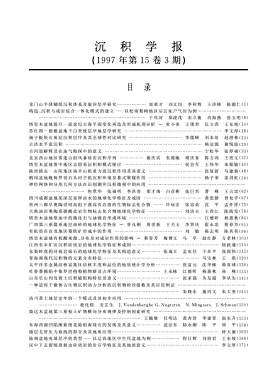Xu Wanhong, Zhang Zhongying, Sheng ping, Meng Qianxiang. Biomarkers From the Xiayangao Member of the Early Ordovician Tonggao Formation in the Sandu Area, Guizhou Province[J]. Acta Sedimentologica Sinica, 1997, 15(3): 72-77.
| Citation:
|
Xu Wanhong, Zhang Zhongying, Sheng ping, Meng Qianxiang. Biomarkers From the Xiayangao Member of the Early Ordovician Tonggao Formation in the Sandu Area, Guizhou Province[J]. Acta Sedimentologica Sinica, 1997, 15(3): 72-77.
|
Biomarkers From the Xiayangao Member of the Early Ordovician Tonggao Formation in the Sandu Area, Guizhou Province
-
1 Department of Earth Sciences,Nanjing University,Nanjing 210093;
-
2 Lanzhou Institute of Geology,Academia Sinica,Lanzhou 730000
- Received Date: 1995-09-25
- Publish Date:
1997-09-10
-
Abstract
Abundant biomarkers( including n-alkanes, acyclic isoprenoid, steranes and terpanes etc. ) have beendetected by GC-MS from the Xiayangao Member of the Early Ordovician Tonggao Formation in the San-du area of the Guizhou Provine. The carbon numbers of n-alkanes range from nC 15 to nC 35 , nC 18 as thehighest peak and nC 29 as the second, nC+ /nC+22 ratios are up to 0. 77 ~ 1. 02, and OEP= 0. 94 ~ 1. 04. Phy-tane is predominant over priatane with a Pr /Ph of 0. 40 ~ 0. 46( average 0. 44) . Hopane series consistmainly of C 27 ~ C 35 -hopanes, a-mong which C 30 -hopane is the most abundant one, and hopane C 27 + C 29 +31 . Tricyclic terpanes are only composed of long-chain ones their carbon numbers ranging from C 20 toC 29 , and strong predominance of C 23 is detected, Steranes consist mainly of C 27 -sterane, C 23 sterane and C29sterane. According to abundance, C 29 -sterane> C27 -sterane> C 28 -sterane, pregnance and 4-methy1 ster-anes are also identified. The composition and distribution of n-alkanes, acyclic isopenoid, terpanes andsteranes, combining with the biota occurring in the same rock samples, seem to show the characteristicsof a reduction environment, and the biomarkers detected from the rock samples might mainly originatefrom algae.
-
References
|
[1]
|
中国科学地球化学研究所,有机地球化学.北京: 科学出版社,1982. |
|
[2]
|
史继扬,向明菊.五环三萜烷的物源和演化.沉积学报, 1991, 9(增刊 ): 26 ~ 33. |
|
[3]
|
华阿新,黄第藩,华北中. 上元古界有机质成烃作用及生物标志物特征. 中国科学院兰州地质研究所生物、气体地球化学开放研究实验室研究年报 ( 1988 — 1989). 北京: 科学出版社,761991: 10 ~ 43. |
|
[4]
|
李任伟,李哲,王志珍,林大兴.分子化石指标在中国东部盆地古环境分析中的应用. 沉积学报, 1988, 6( 4): 108 ~ 118. |
|
[5]
|
范善发,徐芬芳.沉积岩和原油中的 C 15 - C 20 类异戊二烯烃的分布与成熟的关系. 有机地球化学论文集. 北京: 科学出版社, 1986: 68 ~ 73. |
|
[6]
|
宋振亚,陈庸勋.硅藻土有机地球化学特征及其意义. 中国科学院兰州地质研究所生物、气体地球化学开放研究实验室研究年报 ( 1986). 兰州:甘肃科学技术出版社, 1987: 61 ~ 77. |
|
[7]
|
Fan pu, LiJing gui, Meng Qianxiang, Yu Xinke, li Zhenxi.Biomarkers and Other Hydrocarbons in Upper Sinian Stroma-tolitic Dolostones from Southwest China. In: schidlowski et al. ( Eds): Early Organic Evolution: Implication for Mineral andEnerg y Resources. Springer Varlay. 1992: 228 ~ 239. |
|
[8]
|
Clark, R. C& Blumer, M., Distribution of n _ paraffins in ma-rine organisms and sediment. Liminology and Oceanog raphy,1967, 12( 12): 79 ~ 87. |
|
[9]
|
Han J& Calvin M. Hydrocarbon distrbution of alg ae and bacte-riaand microbiological activity in sediments. Nat. Acad. Sci.Proc., 1969, 64: 436 ~ 443. |
|
[10]
|
黄第藩,李晋超,周翥虹等.陆相有机质和成烃原理. 北京: 石油工业出版社, 1984. |
|
[11]
|
吴庆余,刘志礼,盛国英等.前寒武纪富藻燧石层中的生物标志化合物. 中国科学院地球化学研究所机地球化学开放研究
实验室研究年 ( 1986),贵阳: 贵州人民出版社, 1987: 111 ~ 121. |
|
[12]
|
史继扬.陆相沉积物和原油中的 β胡萝卜烷和伽马蜡烷. 有机地球化学论文集,北京: 科学出版社, 1986. |
|
[13]
|
范璞,孟仟祥,程学惠,李景贵.指示沉积古环境的生物标记化合物. 中国科学院兰州地质研究所生、气体地球化学开放研究实验室研究年 ( 1987),兰州: 甘肃科学技术出版社 1988: 48~78. |
|
[14]
|
宋振亚,陈庸勋,高玲,沈平.硅藻土沉积物、萜类生物标志合物特征. 中国科学院兰州地质研究所生物、气体地球化学开放研究实验室研究年报 ( 1987),兰州: 甘肃科学技术出版社,1988: 228 ~ 239. |
|
[15]
|
Grantham, P. J., The occurence of unusual C 27 and C 29 Ster-ane predominances in Two Types Omn crude oil. Org. Geoch,1986, 9( 1): 1 ~ 10. |
-
-
Proportional views

-






 DownLoad:
DownLoad: